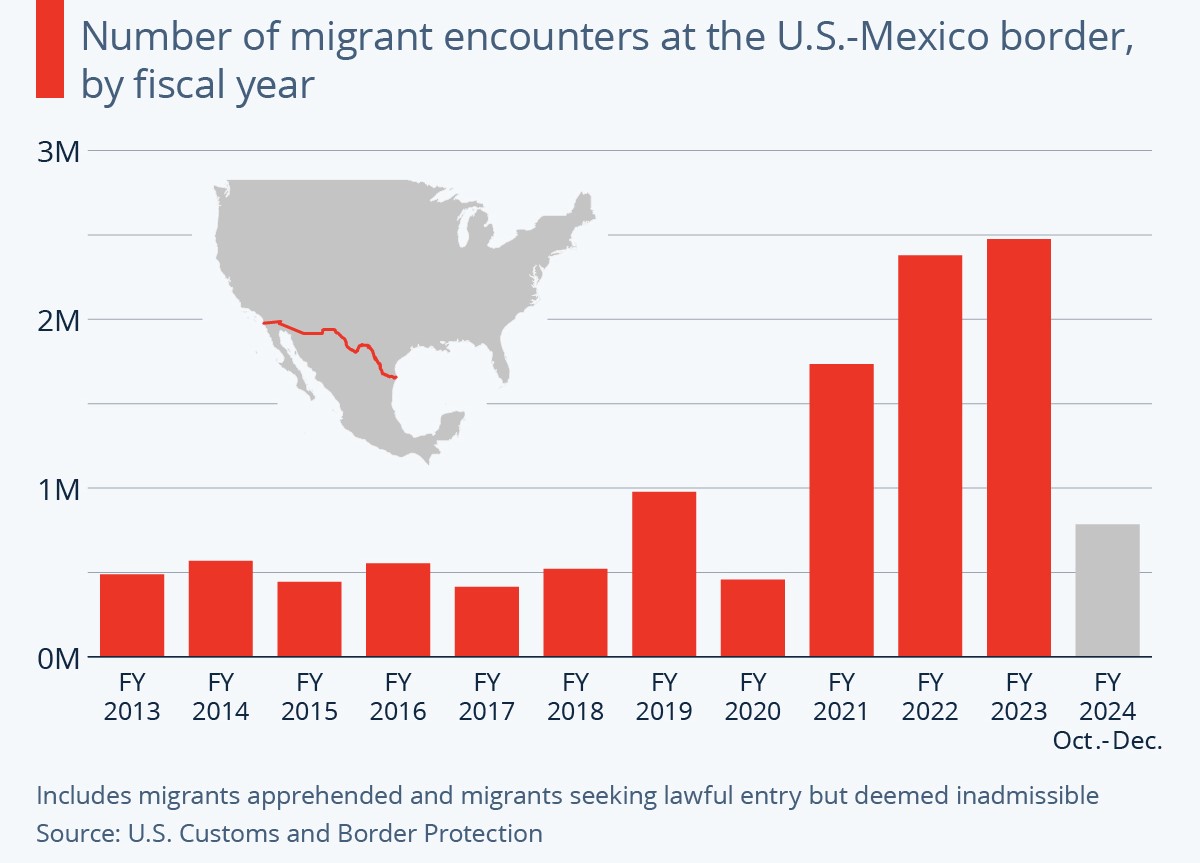The illegal immigration issue as a focus of the presidential race
US President Joe Biden knows that he can defeat rival Donald Trump again if the presidential election in November is about “democracy” and abortion rights, two topics in which he has a clear advantage. His consultants are also confident that the undeniable positive economic results of his administration will just need to be well communicated.
However, Americans seem to prefer to focus elsewhere: A recent Gallup poll shows that the number of people who say immigration is the most important challenge facing America keeps increasing. For the first time since 2019, it is the top issue, at 28% compared with 12% who say the economy is most important. A record 55% of US adults – an increase of 8% compared to 2023 – believe that “large numbers of immigrants entering the United States illegally” is a critical threat to the nation’s interests in the next decade. In another survey (Monmouth), 61% of Americans consider illegal immigration as a “very serious problem”, with a majority of respondents, for the first time, saying they support Trump’s proposal of building a US-Mexico border wall. Furthermore, a recent Harris poll found Biden’s approval rating on immigration to be 35%, his lowest issue among all listed topics.

Although the elections are still months away and the focus on opinion polls is over-emphasized by many, this is definitely not good news for the President. It is true that Republicans have tried to capitalize on immigration fears in recent national elections (2018, 2020 and 2022) with little success. However, now it is different: Trump is talking about immigration non-stop, and the public interest is shifting away from the topics in Biden’s field. As a result, at the beginning of March, the President took a tour to Brownsville, Texas, near the US-Mexico border. This was only the second time that he had visited the southern border during his presidency, despite immigration spiking to record levels under his administration.
Interestingly, earlier in his term, Biden tried to make Vice President Kamala Harris his “border czar”, but, apparently, she did not perform well in that role and she was later re-routed to other dossiers. Until now, Biden has been criticized for failing to engage on this issue, but the recent visit provided an opportunity to demonstrate that he is serious about immigration. Numbers, however, are against him: since Biden took office, illegal crossings have averaged two million a year – a record high. By contrast, in four years of Trump’s presidency, illegal crossings went up to just below one million in 2019 and never topped 600,000 in the remaining three years.

Although the political rhetoric of a presidential campaign inevitably presents an oversimplified picture, the issue is indeed complex on many sides: Congressional Republicans are blocking Senate-passed bipartisan immigration reform legislation in the House of Representatives (the backstory is that Trump wants to deny Biden a victory on border security because he is aiming to continue using the topic during the campaign). At the same time, mayors in major Democrat-run US cities are increasingly critical of the President’s immigration policies – a consequence of the hundreds of thousands of migrants who have arrived in cities like Boston, Chicago and New York, either on their own or with transportation arranged by Republican governors in states like Texas (another Republican strategy aimed at getting Biden in trouble on the issue).
Biden is expected to soon announce tougher border measures and more stringent asylum policies. However, it should not be forgotten that, when he became president, he promised to undo severe Trump policies and take a more “humane” approach.
Read also: Biden’s immigration challenge: Seeking the humane in a difficult political context
That is because the Trump administration’s immigration decisions were simply a failure: early restrictions on immigration from majority-Muslim countries – an attempt at implementing Trump’s so-called “Muslim ban” campaign promise – created chaos at US airports and were often dismantled by local and federal judges. The 2018 policy of separating children and parents in families detained at the border was roundly denounced as cruel, and he was even forced to revert it.
Time has passed, however, citizens have a short memory and political cycles are faster than ever: Trump’s immigration proposals are now even more extreme. He is keen to scale up his past policies, calling for the “largest domestic deportation operation in American history”. He wants to introduce a new travel ban and he is focused on installing extreme limits on birthright citizenship. A centerpiece of his current proposals is inspired by a 1954 policy implemented by President Eisenhower, who deported hundreds of thousands of undocumented Mexican workers. Trump has said that he hopes to establish something similar, with the idea of completing annual deportations that number in the millions. Since 2015 and still now he has made incendiary and racist statements about how immigrants are “poisoning the blood of our country” and coming to the US from “mental institutions”, among others.
All in all, Trump is pressing his perceived advantage on the issue, but he should be cautious in going too far. The harsh rhetoric that resonates with Republican base voters, including those who align to xenophobic ideas, does not really suit most Americans. A large share of the public wants a secure border, but most people also think that legal immigration is a good thing.
Here we go back to the beginning: proposals that are too extreme may backfire, even for Trump. As in the cases of abortion and the protection of democracy, right-wing extremism on immigration may serve Biden’s campaign with an unexpected chance for counterattack.
